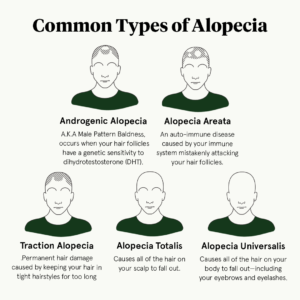Alopecia
Alopecia which involves hair loss, comes in various forms, but the most common is Alopecia areata. Unpredictable hair loss is associated with alopecia areata, an autoimmune disorder. Read More
Top Doctors For Alopecia Treatments
Top Hospitals For Alopecia Treatments
Alopecia
What is Alopecia?
Imagine waking up to find hair strands (many of them) on your pillow. A suspected condition that causes hair loss is called alopecia. Alopecia which involves hair loss, comes in various forms, but the most common is Alopecia areata. Unpredictable hair loss is associated with alopecia areata, an autoimmune disorder. It can occur suddenly and gradually develop in a few days or weeks. An autoimmune disorder is a condition whereby the immune system of one’s body attacks the body. In the case of alopecia, the cells of the hair follicles in the body are being attacked by the white blood cells. This results in the shrinking of the hair follicles, eventually leading to a dramatic reduction in hair production. A dermatologist is a medical doctor specializing in diagnosing and treating various skin conditions, hair, and nails. Alopecia areata can occur anywhere in the body, and it affects just about anyone, males and females alike, of any age, although most reported cases occur before the age of 30. The quantity of hair loss in each individual is different. Some people may lose hair in a few spots, while others may lose lots of hair. In some people, hair may grow back, and in some others, the hair that grows back will come off again. The condition may either be temporary or permanent. Other forms of alopecia are: Alopecia areata totalis is a rare form of alopecia in which all the hair on one’s head is lost completely. Alopecia areata universalis – This is the condition in which hair is lost all over the entire body. Traction alopecia – This occurs from constant pulling of the hair. It is common with people that often wear tight braids. Androgenic alopecia – Also called androgenetic alopecia, it occurs in both males and females and is linked to a response in androgen. It can be genetic and is known as male pattern baldness men where the hair starts thinning out in an “M” pattern. Diffuse alopecia areata – This form of alopecia involves the thinning of hair. Ophiasis alopecia areata – Here, hair is lost around the back and sides of the head in a band shape. Picture courtesy: www.facebook.com
Picture courtesy: www.facebook.com
Symptoms and Risk Factors of Alopecia
Alopecia is a disorder associated with the loss of hair. Other symptoms may include:-
-
- itchy or burning sensation in areas before visible hair loss,
- patches of baldness on the scalp or other affected areas,
- bald patches becoming larger and turning into bald spots,
- hair grows back and falls again,
- loss of hair within a short time,
- losing more hair in the cold weather,
- fingernails and toenails become red, brittle, and pitted.
-
-
-
- the appearance of white spots and lines,
- the appearance of pinpoint dents,
- nails becoming rough,
- loss of nail luster,
- nails becoming thin and split.
-
-
-
- hereditary,
- vitiligo,
- thyroid disease,
- asthma,
- hormonal changes,
- radiation therapy to the head,
- Down syndrome,
- seasonal allergies,
- pernicious anemia,
- hairstyles and treatments
- other medical conditions.
-
When to seek medical advice and diagnosis
When you notice that you are losing your hair for reasons you cannot account for, it is advised to seek professional help. A dermatologist is a doctor to see when someone suffers from alopecia. The dermatologist will:-
-
- review patient’s medical records,
- ask the patient for symptoms experienced,
- closely examine the parts where hair has been lost,
- tug at the hair gently to ensure it comes off easily, which is called the pull test,
- check for abnormally-shaped follicles,
- examine the nails, etc.
-
Treatment for Alopecia
Alopecia areata cannot be cured, but the condition can be managed and treated to help re-grow the hair. Several techniques that one can employ include: Corticosteroids – Although they take too long to work, these powerful anti-inflammatory drugs are prescribed to help people with autoimmune diseases by suppressing their immune systems. They can be given in various forms. i. Pills to be swallowed. ii. Cream, foam, or ointment to be rubbed on the skin. iii. Injection to be injected into the scalp or other affected area. Topic immunotherapy – This form of treatment requires the application of chemicals on the scalp to produce an allergic reaction. It is employed when a lot of hair is lost or if it occurs several times. The allergic reaction is what leads to the growth of hair if the treatment works. However, it may lead to itchy rashes. Minoxidil – Already employed in treating pattern baldness, Minoxidil which is also called Rogaine, can be given to alopecia patients to help with hair growth. Even with this treatment, the hair can take as long as 12 weeks to grow. People with a few bald patches usually have their alopecia disappear without treatment. Their recovery is usually full and spontaneous. People with alopecia may decide to cover their heads with hats, scarves, or wigs. This is not just done to cover their loss of hair but to protect their head from the sun’s rays. Although there is little scientific proof that stress causes alopecia, people with alopecia are advised to reduce stress and avoid things that will stress them. They might also decide to go for hair transplants and contact [email protected] To help individuals with alopecia cope with the anxiety and sadness of losing their hair to a medical condition, they are encouraged to join support groups. These groups provide the needed support to deal with the psychological effects that come with alopecia.Prevention
-
-
- Non-genetic baldness can be prevented, but baldness passed down in one’s generation genetically cannot be prevented.
- The hair should be adequately taken care of gently. Avoid the use of harsh treatments.
- Avoid smoking.
- Seek professional help on medications and supplements you take that may cause hair loss.
- Cover the hair from ultraviolet light and the harsh rays of the sun.
-
FAQ
- Is alopecia hereditary?
Though environmental factors play a role in the onset of alopecia, the condition is also genetically transferred. It has been shown that some people with siblings or parents who have alopecia tend to also have alopecia as well.






















































